Gang Niu
Tokyo Institute of Technology
On the Role of Label Noise in the Feature Learning Process
May 25, 2025Abstract:Deep learning with noisy labels presents significant challenges. In this work, we theoretically characterize the role of label noise from a feature learning perspective. Specifically, we consider a signal-noise data distribution, where each sample comprises a label-dependent signal and label-independent noise, and rigorously analyze the training dynamics of a two-layer convolutional neural network under this data setup, along with the presence of label noise. Our analysis identifies two key stages. In Stage I, the model perfectly fits all the clean samples (i.e., samples without label noise) while ignoring the noisy ones (i.e., samples with noisy labels). During this stage, the model learns the signal from the clean samples, which generalizes well on unseen data. In Stage II, as the training loss converges, the gradient in the direction of noise surpasses that of the signal, leading to overfitting on noisy samples. Eventually, the model memorizes the noise present in the noisy samples and degrades its generalization ability. Furthermore, our analysis provides a theoretical basis for two widely used techniques for tackling label noise: early stopping and sample selection. Experiments on both synthetic and real-world setups validate our theory.
Learning without Isolation: Pathway Protection for Continual Learning
May 24, 2025Abstract:Deep networks are prone to catastrophic forgetting during sequential task learning, i.e., losing the knowledge about old tasks upon learning new tasks. To this end, continual learning(CL) has emerged, whose existing methods focus mostly on regulating or protecting the parameters associated with the previous tasks. However, parameter protection is often impractical, since the size of parameters for storing the old-task knowledge increases linearly with the number of tasks, otherwise it is hard to preserve the parameters related to the old-task knowledge. In this work, we bring a dual opinion from neuroscience and physics to CL: in the whole networks, the pathways matter more than the parameters when concerning the knowledge acquired from the old tasks. Following this opinion, we propose a novel CL framework, learning without isolation(LwI), where model fusion is formulated as graph matching and the pathways occupied by the old tasks are protected without being isolated. Thanks to the sparsity of activation channels in a deep network, LwI can adaptively allocate available pathways for a new task, realizing pathway protection and addressing catastrophic forgetting in a parameter-efficient manner. Experiments on popular benchmark datasets demonstrate the superiority of the proposed LwI.
Robust Multi-View Learning via Representation Fusion of Sample-Level Attention and Alignment of Simulated Perturbation
Mar 06, 2025



Abstract:Recently, multi-view learning (MVL) has garnered significant attention due to its ability to fuse discriminative information from multiple views. However, real-world multi-view datasets are often heterogeneous and imperfect, which usually makes MVL methods designed for specific combinations of views lack application potential and limits their effectiveness. To address this issue, we propose a novel robust MVL method (namely RML) with simultaneous representation fusion and alignment. Specifically, we introduce a simple yet effective multi-view transformer fusion network where we transform heterogeneous multi-view data into homogeneous word embeddings, and then integrate multiple views by the sample-level attention mechanism to obtain a fused representation. Furthermore, we propose a simulated perturbation based multi-view contrastive learning framework that dynamically generates the noise and unusable perturbations for simulating imperfect data conditions. The simulated noisy and unusable data obtain two distinct fused representations, and we utilize contrastive learning to align them for learning discriminative and robust representations. Our RML is self-supervised and can also be applied for downstream tasks as a regularization. In experiments, we employ it in unsupervised multi-view clustering, noise-label classification, and as a plug-and-play module for cross-modal hashing retrieval. Extensive comparison experiments and ablation studies validate the effectiveness of RML.
Accurate Forgetting for Heterogeneous Federated Continual Learning
Feb 20, 2025Abstract:Recent years have witnessed a burgeoning interest in federated learning (FL). However, the contexts in which clients engage in sequential learning remain under-explored. Bridging FL and continual learning (CL) gives rise to a challenging practical problem: federated continual learning (FCL). Existing research in FCL primarily focuses on mitigating the catastrophic forgetting issue of continual learning while collaborating with other clients. We argue that the forgetting phenomena are not invariably detrimental. In this paper, we consider a more practical and challenging FCL setting characterized by potentially unrelated or even antagonistic data/tasks across different clients. In the FL scenario, statistical heterogeneity and data noise among clients may exhibit spurious correlations which result in biased feature learning. While existing CL strategies focus on a complete utilization of previous knowledge, we found that forgetting biased information is beneficial in our study. Therefore, we propose a new concept accurate forgetting (AF) and develop a novel generative-replay method~\method~which selectively utilizes previous knowledge in federated networks. We employ a probabilistic framework based on a normalizing flow model to quantify the credibility of previous knowledge. Comprehensive experiments affirm the superiority of our method over baselines.
Learning Locally, Revising Globally: Global Reviser for Federated Learning with Noisy Labels
Nov 30, 2024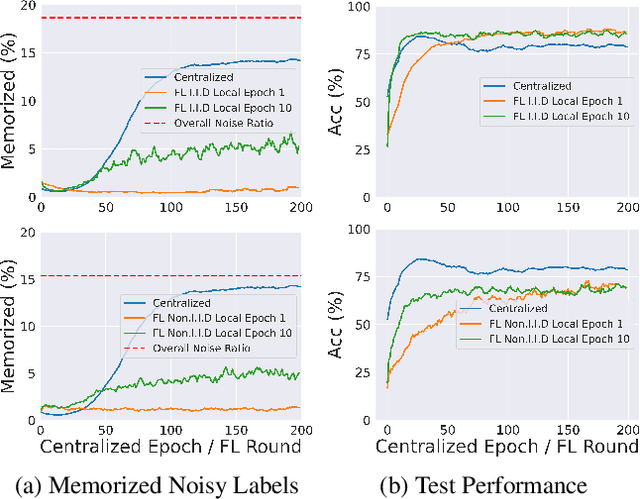
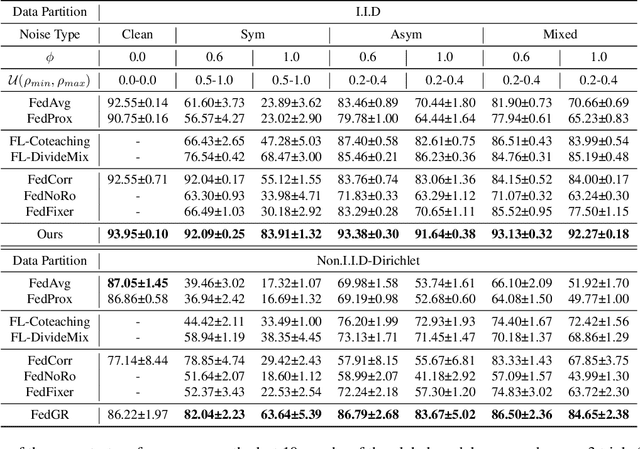
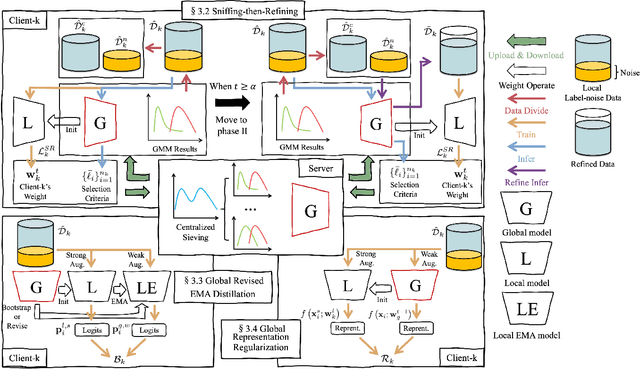
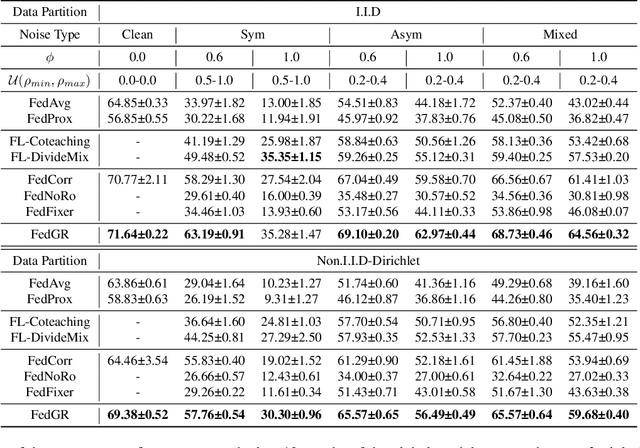
Abstract:The success of most federated learning (FL) methods heavily depends on label quality, which is often inaccessible in real-world scenarios, such as medicine, leading to the federated label-noise (F-LN) problem. In this study, we observe that the global model of FL memorizes the noisy labels slowly. Based on the observations, we propose a novel approach dubbed Global Reviser for Federated Learning with Noisy Labels (FedGR) to enhance the label-noise robustness of FL. In brief, FedGR employs three novel modules to achieve noisy label sniffing and refining, local knowledge revising, and local model regularization. Specifically, the global model is adopted to infer local data proxies for global sample selection and refine incorrect labels. To maximize the utilization of local knowledge, we leverage the global model to revise the local exponential moving average (EMA) model of each client and distill it into the clients' models. Additionally, we introduce a global-to-local representation regularization to mitigate the overfitting of noisy labels. Extensive experiments on three F-LNL benchmarks against seven baseline methods demonstrate the effectiveness of the proposed FedGR.
On Unsupervised Prompt Learning for Classification with Black-box Language Models
Oct 04, 2024



Abstract:Large language models (LLMs) have achieved impressive success in text-formatted learning problems, and most popular LLMs have been deployed in a black-box fashion. Meanwhile, fine-tuning is usually necessary for a specific downstream task to obtain better performance, and this functionality is provided by the owners of the black-box LLMs. To fine-tune a black-box LLM, labeled data are always required to adjust the model parameters. However, in many real-world applications, LLMs can label textual datasets with even better quality than skilled human annotators, motivating us to explore the possibility of fine-tuning black-box LLMs with unlabeled data. In this paper, we propose unsupervised prompt learning for classification with black-box LLMs, where the learning parameters are the prompt itself and the pseudo labels of unlabeled data. Specifically, the prompt is modeled as a sequence of discrete tokens, and every token has its own to-be-learned categorical distribution. On the other hand, for learning the pseudo labels, we are the first to consider the in-context learning (ICL) capabilities of LLMs: we first identify reliable pseudo-labeled data using the LLM, and then assign pseudo labels to other unlabeled data based on the prompt, allowing the pseudo-labeled data to serve as in-context demonstrations alongside the prompt. Those in-context demonstrations matter: previously, they are involved when the prompt is used for prediction while they are not involved when the prompt is trained; thus, taking them into account during training makes the prompt-learning and prompt-using stages more consistent. Experiments on benchmark datasets show the effectiveness of our proposed algorithm. After unsupervised prompt learning, we can use the pseudo-labeled dataset for further fine-tuning by the owners of the black-box LLMs.
Dual-Decoupling Learning and Metric-Adaptive Thresholding for Semi-Supervised Multi-Label Learning
Jul 26, 2024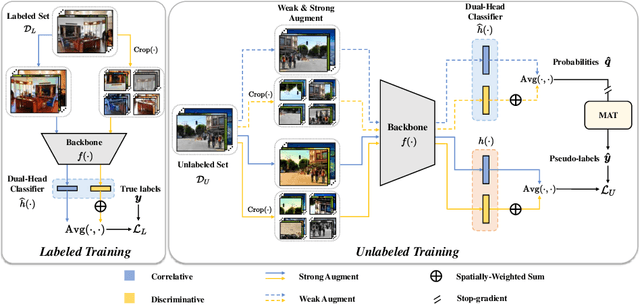
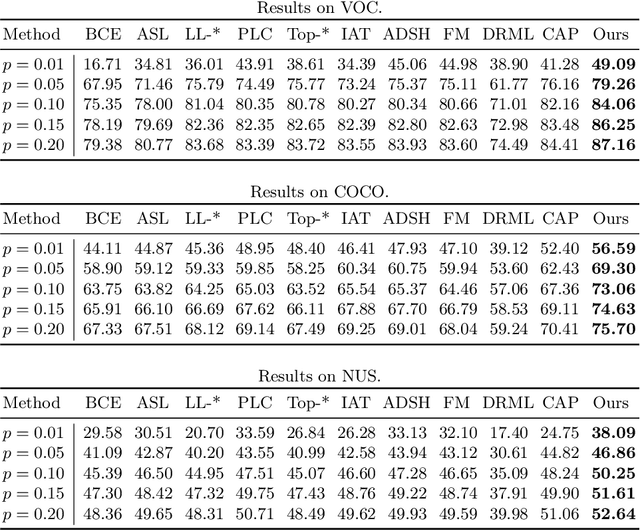


Abstract:Semi-supervised multi-label learning (SSMLL) is a powerful framework for leveraging unlabeled data to reduce the expensive cost of collecting precise multi-label annotations. Unlike semi-supervised learning, one cannot select the most probable label as the pseudo-label in SSMLL due to multiple semantics contained in an instance. To solve this problem, the mainstream method developed an effective thresholding strategy to generate accurate pseudo-labels. Unfortunately, the method neglected the quality of model predictions and its potential impact on pseudo-labeling performance. In this paper, we propose a dual-perspective method to generate high-quality pseudo-labels. To improve the quality of model predictions, we perform dual-decoupling to boost the learning of correlative and discriminative features, while refining the generation and utilization of pseudo-labels. To obtain proper class-wise thresholds, we propose the metric-adaptive thresholding strategy to estimate the thresholds, which maximize the pseudo-label performance for a given metric on labeled data. Experiments on multiple benchmark datasets show the proposed method can achieve the state-of-the-art performance and outperform the comparative methods with a significant margin.
Decoupling the Class Label and the Target Concept in Machine Unlearning
Jun 12, 2024



Abstract:Machine unlearning as an emerging research topic for data regulations, aims to adjust a trained model to approximate a retrained one that excludes a portion of training data. Previous studies showed that class-wise unlearning is successful in forgetting the knowledge of a target class, through gradient ascent on the forgetting data or fine-tuning with the remaining data. However, while these methods are useful, they are insufficient as the class label and the target concept are often considered to coincide. In this work, we decouple them by considering the label domain mismatch and investigate three problems beyond the conventional all matched forgetting, e.g., target mismatch, model mismatch, and data mismatch forgetting. We systematically analyze the new challenges in restrictively forgetting the target concept and also reveal crucial forgetting dynamics in the representation level to realize these tasks. Based on that, we propose a general framework, namely, TARget-aware Forgetting (TARF). It enables the additional tasks to actively forget the target concept while maintaining the rest part, by simultaneously conducting annealed gradient ascent on the forgetting data and selected gradient descent on the hard-to-affect remaining data. Empirically, various experiments under the newly introduced settings are conducted to demonstrate the effectiveness of our TARF.
Locally Estimated Global Perturbations are Better than Local Perturbations for Federated Sharpness-aware Minimization
May 29, 2024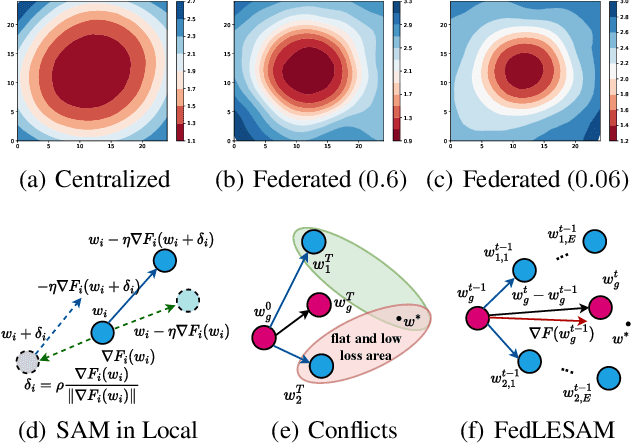



Abstract:In federated learning (FL), the multi-step update and data heterogeneity among clients often lead to a loss landscape with sharper minima, degenerating the performance of the resulted global model. Prevalent federated approaches incorporate sharpness-aware minimization (SAM) into local training to mitigate this problem. However, the local loss landscapes may not accurately reflect the flatness of global loss landscape in heterogeneous environments; as a result, minimizing local sharpness and calculating perturbations on client data might not align the efficacy of SAM in FL with centralized training. To overcome this challenge, we propose FedLESAM, a novel algorithm that locally estimates the direction of global perturbation on client side as the difference between global models received in the previous active and current rounds. Besides the improved quality, FedLESAM also speed up federated SAM-based approaches since it only performs once backpropagation in each iteration. Theoretically, we prove a slightly tighter bound than its original FedSAM by ensuring consistent perturbation. Empirically, we conduct comprehensive experiments on four federated benchmark datasets under three partition strategies to demonstrate the superior performance and efficiency of FedLESAM.
Balancing Similarity and Complementarity for Federated Learning
May 16, 2024



Abstract:In mobile and IoT systems, Federated Learning (FL) is increasingly important for effectively using data while maintaining user privacy. One key challenge in FL is managing statistical heterogeneity, such as non-i.i.d. data, arising from numerous clients and diverse data sources. This requires strategic cooperation, often with clients having similar characteristics. However, we are interested in a fundamental question: does achieving optimal cooperation necessarily entail cooperating with the most similar clients? Typically, significant model performance improvements are often realized not by partnering with the most similar models, but through leveraging complementary data. Our theoretical and empirical analyses suggest that optimal cooperation is achieved by enhancing complementarity in feature distribution while restricting the disparity in the correlation between features and targets. Accordingly, we introduce a novel framework, \texttt{FedSaC}, which balances similarity and complementarity in FL cooperation. Our framework aims to approximate an optimal cooperation network for each client by optimizing a weighted sum of model similarity and feature complementarity. The strength of \texttt{FedSaC} lies in its adaptability to various levels of data heterogeneity and multimodal scenarios. Our comprehensive unimodal and multimodal experiments demonstrate that \texttt{FedSaC} markedly surpasses other state-of-the-art FL methods.
 Add to Chrome
Add to Chrome Add to Firefox
Add to Firefox Add to Edge
Add to Edge